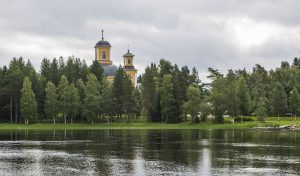Have you ever heard Lord of the Rings? Yes, that famous Lord of the Rings. J. R. R. Tolkien, the author, was greatly influenced by the Finnish national epic Kalevala. He also based elements of his Elvish language Quenya on Finnish language. So why you have never heard of it? Let’s explore this hidden gem of the world literature with me!
Elias Lönnrot – the compiler of Kalevala
Lönnrot used to work as district doctor of Kajaani. In 1854, he became the Professor of the Finnish language at the University of Helsinki. While he worked as a doctor, he collected old Finnish poems in many of his trips in the Viena district of Russian Karelia. Lönnrot didn’t emphasize on the Runosingers from whom he heard these poems. The poems, he believed, belonged to everybody.

However, the poems in Kalevala are not exact copies of the folk poems Lönnrot collected during his trips. He edited, fixed, and rearranged verses from different poems, and even added his own. He tried to place poems on a coherent timeline as if they were historical events. Christian-related and modern elements were removed. Sometimes, he would also change the names of people and places.
In a word, Kalevala marked an important turning point for Finnish-language culture. It brought a small, unknown people to the attention of other Europeans. It also strengthened the Finns’ self-confidence and faith in the possibilities of the Finnish language and culture.
Land of Kalevala – Where heroes and gods can also be vulnerable
Kalevala takes place in the land of beautiful and green Kalevala, in Väinölä. That is where Väinämöinen and many of the other characters live. There is also the land of animals and forest people, the land of the water, and the land of the deceased. Väinämöinen, an old sorcerer, rules Kalevala. He practices his sorcery by singing and playing the kantele. Meanwhile, the witch-like Louhi is the ruler of Pohjola. In summary, Kalevala is a story of the various battles between Väinölä and its enemy Pohjola.
The Kalevala begins with the traditional Finnish creation myth. It leads into stories of the creation of the earth, plants, creatures, and the sky. Creation, healing, combat and internal story telling are often accomplished by the characters. They sing about their exploits or desires. Characters often have to acquire some skill, such as boat-building or the mastery of iron making. In order to do so, they must hunt or request lyrics (spells) from mother nature. In addition, there are many stories of lust, romance, kidnapping and seduction.

However, the main characters again and again have to accomplish feats that are unreasonable or impossible. As no surprise, they often fail to achieve, leading to tragedy or humiliation. Thus, it is a story of betrayal, jealousy, revenge, greed, masculinity and feminity. The epic ends with the birth of a baby boy and Väinämöinen leaving.
Visit Kalevala Society Foundation to read more about the epic in English!
Kuhmo – Home of the Finnish epic
The city of Kuhmo has been designated as a city of literature of the UNESCO Creative Cities Network. Kuhmo’s application based on the idea of Kuhmo as the home of the Kalevala. This Finnish national epic and its runosinging have been the cornerstones of culture and identity of the Finnish people and Finland.

In Kuhmo, cultural and tourism activities strongly present the spirit of national epic Kalevala. The folklore is on display at the Kalevala Spirit Experience Park. Besides, Kalevala and Karelian Information Centre, Juminkeko, also hosts temporary exhibitions inspired by this epic. Furthermore, the annual Sommelo folk music festival with its poem singing has a strong Kalevala feel to it.
Interested in this epic of Finnish people? Give Kalavala a chance! And don’t forget to visit Kuhmo to fall in love with its nature and cultural heritage ❤
Also have a look at Milla’s blog Sustainability in Kuhmo: Literary Tourism to understand more about Kalevala and Kuhmo as a literary tourism destination!
One Comment